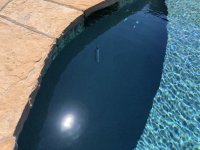As mentioned in post #44 above, my pool temperature sensor was hanging half in and half out of the equalizer tube connecting my auto-leveler system to the pool. This had three problems:
- the sensor was vulnerable to kids or my pool vac messing with it, and
- the flow of the fill water was affecting the temperature reading, and
- the sensor and a bunch of its wire all coiled up in the equalizer pipe was affecting the fill-water flow.
@kimkats had given me the idea to en-cage it somehow, and I finally got around to it.
I fabricated a cage out of 3/4" grey PVC. Then I shaved off a side so that there would be a decent glue surface.
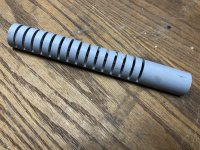
Sanding the shaved side with a belt sander left a couple of handy PVC flaps that made the glue surface a little wider.
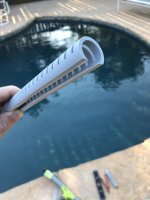
I got in the pool with a mask and snorkel and plotted the position I wanted it with a level and a pencil. Then I tried out my idea of using my new ProTuff pole as some sort of clamping mechanism. I had several ideas to try, to make that work, but it turned out the simplest was all I needed. The pole was virtually the exact length I needed (jammed between the two sides of my pool), and my brush did a perfect job of holding the cage in place. I practiced assembling the pole and cage against the wall, so that I wouldn't be trying to figure that part out with the epoxy applied.
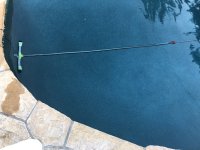
Then I gloved up and mixed and applied the underwater epoxy to the cage. That did not go well at all. The epoxy was quite unruly and the gloves made it worse. I did the best I could, then scrambled back into the water to get the cage in place before the epoxy set. It ended up being a bit sloppier than I was hoping for, but it's the kind of thing that the more you mess with it, the worse it gets, so I left well enough alone.
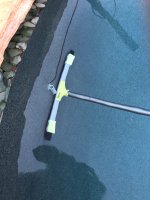
I pushed on the cage as best I could, to try and embed the epoxy. I had no idea if that was working or not. And trying to push anything against a pool wall doesn't work well at all. Like I imagine working in outer space would be.
Then I had to disengage the vac, so it wouldn't upset the pole during its mid-night run. I decided not to mess with the programming, and I couldn't just remove it. I didn't want to turn off the breakers either, so I just did this instead:
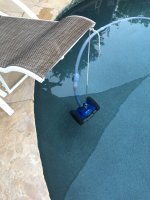
This morning I removed the pole, half expecting the cage to just fall off. It didn't. So I pushed on it a bit. Then a lot. The epoxy seems to be holding very strong. We'll see if it lasts. I then fitted the sensor into the cage and shortened and re-soldered its wire so that the extra slack I had previously stored coiled up in the equalizer pipe was reduced to a single strand. Much cleaner and now the wire won't impede the flow of water through the tube.
It's uglier than I had hoped. The grey of the PVC is better than white, but not as invisible as I had envisioned. But now the sensor is protected and out of the flow of fill water. It's not any uglier than one of those tied-up, dangling pool thermometers, I suppose. But this one talks to my home automation system and I use its reading many times each day, even in the off season. So it's a trade off.
It's possible cooler, freshwater fill water coming out of the equalizer tube could drop downward and affect the temperature of the sensor. I tested for that as best I could and didn't see that effect. If it does, it'll be in the 0.1° range, which I can live with. I might find a way to plug the top of the cage to minimize that, but that's not a concern for now.
Like my water level ruler project, if I find I dont like this gizmo, or it doesn't work out, I can always try something else. But this project is almost done. Just have to hide the wire that crosses the deck. That's a project for another day.
